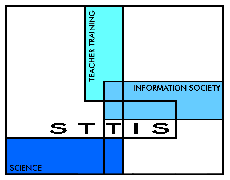Guide
|
The
nature of the innovation
Nowadays, both in education
research and in school
practice, increasing attention is paid to modelling activities, and
there
is wide consensus concerning the educational usefulness of learning how
to interpret and build computer models. A discussion of the benefits of
computer modelling and of the range of activities that can be
undertaken
in the classroom can be found in Briefing
Sheet
2 ‘Why use computer models?’.
The choice of the UK
group to study the transformations
science teachers make of the use of computer modelling reflects both
our
acknowledgement of its great educational potential and our resolve to
work
towards removing some of the obstacles for its incorporation in the
secondary
curriculum. Some of the other groups in the STTIS consortium also chose
to look at computer modelling, some chose to look at another important
use of informatic tools in science teaching, namely datalogging or MBL
(microcomputer-based laboratory). The training materials presented here
draw on the findings of the STTIS research as a whole on the use of
informatic
tools.
In our study of the
use of computer modelling
we focus on the use of spreadsheets in different physics topics.
Spreadsheets
have a number of attributes which make them suitable for use as a
modelling
tool in the school laboratory and thus popular with the science
teachers.
In these training materials, we have chosen to look in particular at
the
use of spreadsheets for modelling in two contexts – ‘Electricity’ and
‘Forces
and motion’.
|

 Teaching with computer models
Teaching with computer models

